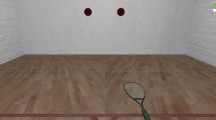Abstract
Models of eye movements of an observer searching for human targets are helpful in developing accurate models of target acquisition times and false positive detections. We develop a new model describing the distribution of gaze positions for an observer which includes both bottom-up (salience) and top-down (task dependent) factors. We validate the combined model against a bottom-up model from the literature and against the bottom up and top down parts alone using human performance data on stationary targets. The new model is shown to be significantly better. The new model requires a large amount of data about the terrain and the target that is obtained directly from the 3D simulation through an automated process.
Similar content being viewed by others
References
Buscher G, Cutrell E, Morris M (2009) What do you see when you’re surfing? using eye tracking to predict salient regions of web pages. In: Proceedings of CHI 2009, human factors in computing systems. ACM, New York, pp 21–30
Darken CJ (2007a) Computer graphics-based models of target detection: algorithms, comparison to human performance, and failure modes. J Defense Model Simul, Appl Methodol Technol 4
Darken CJ (2007b) Level annotation and test by autonomous exploration. In: Proceedings of artificial intelligence and interactive digital entertainment (AIIDE)
Einhäuser W, Spain M, Perona P (2008) Objects predict fixations better than early saliency. J Vis 8:1–26
Evangelista PF, Darken CJ, Jungkunz P (2010) Modeling and integration of situational awareness and soldier target search. J Defense Model Simul, Appl Methodol Technol 1–19. doi:10.1177/1548512911415726
Fawcett T (2006) An introduction to ROC analysis. Pattern Recognit Lett 27:861–874
Frintrop S (2006) VOCUS: a visual attention system for object detection and goal-directed search. Springer, Berlin
Hanley JA, McNeil BJ (1982) The meaning and use of the area under a receiver operating characteristic (ROC) curve. Radiology 143:29–36
Henderson JM (2003) Human gaze control during real-world scene perception. Trends Cogn Sci 7:498–504
Henderson JM, Weeks PA, Hollingworth A (1999) The effects of semantic consistency on eye movements during complex scene viewing. J Exp Psychol Hum Percept Perform 25:210–228
Hoffman JE, Subramaniam B (1995) The role of visual attention in saccadic eye movements. Percept Psychophys 57(6):787–795
Itti L (2003) Visual attention. In: Arbib MA (ed) The handbook of brain theory and neural networks. MIT Press, Cambridge, pp 1196–1201
Itti L, Koch C (2001a) Computational modeling of visual attention. Nat Rev, Neurosci 2(3):194–203
Itti L, Koch C (2001b) Feature combination strategies for saliency-based visual attention systems. J Electron Imaging 10:161–169
Itti L, Koch C, Niebur E (1998) A model of saliency-based visual attention for rapid scene analysis. IEEE Trans Pattern Anal Mach Intell 20(11):1254–1259
Jungkunz P (2009) Modeling human visual perception for target detection in military simulations. PhD thesis, Naval Postgraduate School
Mannan SK, Ruddock KH, Wooding DS (1997) Fixation patterns made during brief examination of two-dimensional images. Perception 26:1059–1072
Navalpakkam V, Itti L (2005) Modeling the influence of task on attention. Vis Res 45(2):205–231
Pomplun M (2006) Saccadic selectivity in complex visual search displays. Vis Res 46:1886–1900
Rayner K, Pollatsek A (1992) Eye movements and scene perception. Can J Psychol 46:342–376
Tatler BW, Baddeley RJ, Glichrist ID (2005) Visual correlates of fixation selection: effects of scale and time. Vis Res 45:643–659
Torralba A, Oliva A, Castelhano MS, Henderson JM (2006) Contextual guidance of eye movements and attention in real-world scenes: the role of global features in object search. Psychol Rev 113:766–786
Veksler V, Gray W (2007) Mapping semantic relevancy of information displays. In: CHI 2007 extended abstracts on human factors in computing systems. ACM, New York, pp 2729–2734
Wainwright RK (2008) Look again: an investigation of false positive detections in combat models. Master’s thesis, Naval Postgraduate School
Author information
Authors and Affiliations
Corresponding author
Rights and permissions
About this article
Cite this article
Jungkunz, P., Darken, C.J. A computational model for human eye-movements in military simulations. Comput Math Organ Theory 17, 229–250 (2011). https://doi.org/10.1007/s10588-011-9091-9
Published:
Issue Date:
DOI: https://doi.org/10.1007/s10588-011-9091-9




